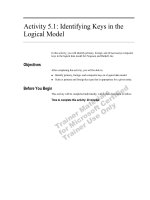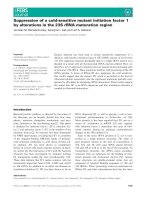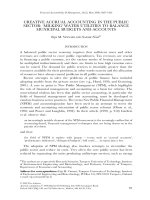Chapter 1 managerial accounting in the information age
Bạn đang xem bản rút gọn của tài liệu. Xem và tải ngay bản đầy đủ của tài liệu tại đây (215.52 KB, 30 trang )
Chapter 1
Managerial Accounting in the
Information Age
CMA
Presentation Outline
I. Goal of Managerial Accounting
II. Comparison of Managerial and Financial
Accounting
III. Variable vs. Fixed Costs
IV. Other Cost Terminology
V. Key Issues in Managerial Accounting
VI. Other Topics
I. Goal of Managerial
Accounting
The goal of managerial accounting is to
provide information that managers need
for:
A. Planning
B. Control
C. Decision Making
A. Planning
Plan
Action taken to
Implement plan
Plans communicate goals to employees to coordinate functions such
as sales and production. Financial plans are often expressed in the
form of budgets (i.e., profit, cash, production budgets)
B. Control
Plan
Action taken to
Implement plan
Results
Comparison of
planned and actual
results
Evaluation
Performance reports compare actual with planned (budgeted)
performance. Management by exception is used meaning that only
significant deviations are investigated (see Illustration 1-3 on p. 5)
C. Decision Making
Plan
Decisions to
change operations
or revise plans
Action taken to
Implement plan
Decisions to
reward or punish
managers
Comparison of
planned and actual
results
Results
Evaluation
The distinction between evaluating managers and evaluating the
operations they control is important. For example, an evaluation of
an operation can be negative even when the manager evaluation is
positive.
II. Comparison of Managerial
and Financial Accounting
A. The User of the Information
B. The GAAP Requirement
C. The Level of Detail
D. The Emphasis on Nonmonetary
Information
E. The Time Frame of Focus
A. The User of the Information
Managerial Accounting
Primarily used by
internal users such as
company managers.
Financial Accounting
Primarily aimed at
external users such as
investors, creditors,
and government
agencies.
B. The GAAP Requirement
Managerial Accounting
Generally accepted
accounting principles
is optional. Use any
reporting convention
that is useful to
management.
Financial Accounting
Publicly traded
companies and many
private companies use
generally accepted
accounting principles
for financial
accounting.
GAAP only
C. The Level of Detail
Managerial Accounting
Managers need detailed
information to plan,
control, and make
decisions about different
organizational areas.
Financial Accounting
External users of
information are often
satisfied with more
summarized
information.
D. The Emphasis on
Nonmonetary Information
Managerial Accounting
Monetary information is
supplemented with
additional detail such as
quantity of materials used,
number of labor hours, etc.
Financial Accounting
Primarily includes
information regarding
assets, liabilities,
equity, revenues,
expenses, and cash
flows.
E. The Time Frame of Focus
Managerial Accounting
Uses past performance to
the extent it is useful
in making predictions
about the future.
Financial Accounting
Primarily presents the
results of past
transactions.
III. Variable vs. Fixed Costs
A. Variable Cost Per Unit
B. Variable Cost in Total
C. Fixed Cost Per Unit
D. Fixed Cost in Total
A. Variable Cost Per Unit
Variable cost per unit remains constant.
$
Variable cost
per unit
Level of Activity
B. Variable Cost in Total
Total variable cost increases and decreases in
proportion to changes in the activity level.
(See illustration on the bottom of page 7)
$
Variable cost
in total
Level of Activity
C. Fixed Cost Per Unit
Fixed cost decrease per unit as the activity level
rises, and increase per unit as the activity level
falls..
$
Fixed cost
per unit
Level of Activity
D. Fixed Cost in Total
Total fixed cost is not affected by changes in the activity
level within the relevant range (i.e., total fixed cost
remains constant even if the activity level changes.
(See illustration in the middle of page 8)
$
Total fixed
cost
Level of Activity
IV. Other Cost Terminology
A. Sunk Costs
B. Opportunity Costs
C. Direct and Indirect Costs
D. Controllable and Noncontrollable Costs
A. Sunk Cost
Costs that have been incurred in the past are
irrelevant. They are known as sunk costs
and make no difference in future decisions
because they do not differ between
alternative courses of action.
I have got to make
this work out or I
will look bad!
B. Opportunity Cost
Opportunity costs are the benefits forgone when one
decision alternative is selected over another. For
example, extra floor space could be rented out or
used to add production capacity. The decision
must consider the lost rental income if the floor
space is used for production.
C. Direct and Indirect Costs
Direct costs are conveniently traceable to a cost
object (i.e., product, activity, department).
Indirect costs cannot be conveniently traced to a
cost object.
Note: The distinction between a direct and indirect
cost depends on the object of the cost tracing.
(See Illustration 1-4 on page 9)
D. Controllable and Noncontrollable
Costs
A manager can influence a controllable cost but
cannot influence an uncontrollable cost. A cost is
that is controllable at a higher management level
may be uncontrollable when allocated to a lower
management level. A manager should not be
evaluated unfavorably strictly because a
noncontrollable cost increases.
V. Key Ideas in Managerial
Accounting
A. Incremental Analysis
B. You Get What You Measure
A. Incremental Analysis
Incremental analysis is the appropriate way to
approach the solution to all business problems. It
involves the difference between the difference in
revenue versus the difference in cost between
decision alternatives. Only differences are relevant
to a decision (See illustrations on pages 10 and 11)
Does the above statement means that fixed costs are
always irrelevant and variable costs are always
relevant?
B. You Get What You Measure
Companies can select from a vast number of
performance measures (profit, new customer sales,
number of defects, etc.)
Since rewards will often depend on how well an
employee performs on a particular measure,
employees direct their attention to what is measured
and may neglect what isn’t measured.
For example, suppose employees were evaluated on
quantity of production with little concern for
product quality.









